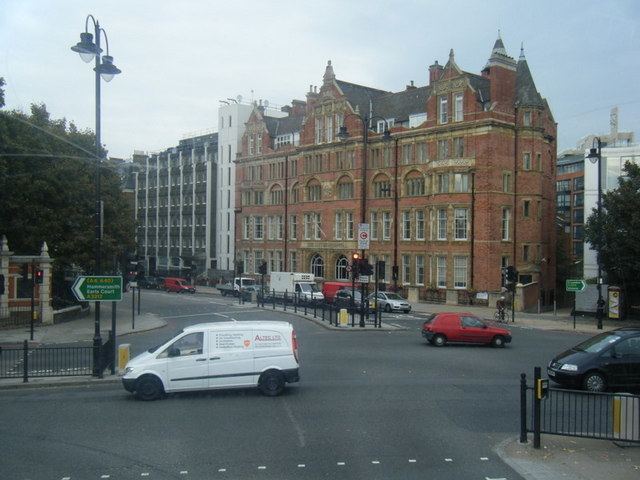 | ||
The Lister Institute of Preventive Medicine, informally known as the Lister Institute, was established as a research institute (the British Institute of Preventive Medicine) in 1891, with bacteriologist Marc Armand Ruffer as its first director, using a grant of £250,000 from Edward Cecil Guinness of the Guinness family. It had premises in Chelsea in London, Sudbury in Suffolk, and Elstree in Hertfordshire, England. It was the first medical research charity in the United Kingdom. It was renamed the Jenner Institute (after Edward Jenner the pioneer of smallpox vaccine) in 1898 and then, in 1903, as the Lister Institute in honour of the great surgeon and medical pioneer, Dr Joseph Lister. In 1905, the institute became a School of the University of London.
Contents
History
Until the 1970s the Institute maintained laboratories and conducted research on infectious disease and vaccines. It was funded by manufacturing and selling vaccines.
In the 1970s the institute ran into financial difficulties. From 1971–72 Professor David Gwynne Evans was the director. The institute had continual annual deficits. Evans was unable to avoid closure of the Chelsea Laboratory and there was the need for major expenditure to modernise the Elstree, Hertfordshire, production facilities. Professor Albert Neuberger became involved as chair of the governing body in 1973-74, at which point he became aware of the difficult financial problems. The endowment funds were insufficient to cover their requirements and it failed to get Government support. Neuberger came to the conclusion that within five to six years it would be bankrupt and he persuaded colleagues to dissolve the Institute. He persuaded Westminster Council to change the use of buildings. The Chelsea laboratories were closed in 1975 and Elstree in 1978. The assets were sold, the most valuable being the Chelsea site.
This raised enough money to annually endow a number of Senior Research Fellowships, which is the Institute's legacy. From that point it became a science funding body, and it now awards the Lister Institute Research Prize Fellowships to researchers working on biomedical problems in the United Kingdom. The Institute's assets in 2010 amounted to about £33m.
Achievements
Staff took considerable risks in early research: investigating plague in India in the early 20th century the method of transmission was established when a female worker put her hand into a flea cage and saw how high the fleas jumped. Joseph Arthur Arkwright FRS (great grandson of Richard Arkwright) joined the institute in 1906 and studied typhus, amongst other things, by allowing himself to be bitten by infected lice. He survived, two others did not. Other major achievements include:
Prior to the First World War
These included the physiology of diving; the lethal effect of ultraviolet light on bacteria; fat metabolism; the role of vitamins in nutrition (the term 'vitamine' was coined by Casimir Funk when working at the institute).
In 1903, Sir Charles James Martin, became the first director of the institute. He made outstanding contributions to the study of plague and its transmission and he created a new post of resident statistician for Major Greenwood, the first of its kind in Britain. Greenwood conducted statistical investigations of tuberculosis, infant mortality and hospital fatality rates. Major also interpreted data from the institute's epidemiological study of bubonic plague in India.
First World War
Tetanus antiserum production at Elstree was increased. The bacteria causing gas gangrene of infected wounds were identified.
Inter-war years
The discovery of co-enzymes by Sir Arthur Harden FRS and his colleagues winning him a share of a Nobel Prize in 1929. The institute played a major part in defining the role of vitamins in post-war nutritional deficiency diseases that were widespread in Europe and elsewhere. Emmy Klieneberger-Nobel pioneered the study of mycoplasma and in 1935 discovered and cultured unusual strains of bacteria that lacked a cell wall, naming them L-form bacteria after the institute where she worked. The first director, Sir Charles Martin, appointed in 1903, retired in 1930.
Second World War
The war made heavy demands on the Lister for production of antisera and vaccines. There was also need for expertise in nutrition. In 1943, Sir Alan Nigel Drury FRS became Director serving until 1952. During the war, departments had been widely dispersed.He began a successful reintegration and incorporated some Medical Research Council (MRC) units. As a result, it became a national centre for research on blood transfusion and the provision of blood products for clinical use.
Post war to 1970s
The institute took some time to settle after wartime upheaval. In 1952 Ashley Miles was appointed as director. The institute remained an important manufacturer of vaccines and antitoxins. It produced the 'triple vaccine' for diphtheria, tetanus and pertussis (commonly called whooping cough) and vaccines for cholera, typhoid, rabies vaccines and smallpox. It also produced antisera for diphtheria, tetanus, gas gangrene, rabies and scorpion venom. There were also further important research activities:
Biochemistry
Blood and blood products
Microbiology and immunology
Vaccines and antitoxins
Nutrition
Elstree
The old Elstree site is located off the north-west side of Dagger Lane, off Tylers Way, Bushey, between the Hillfield Park and Aldenham reservoirs in Aldenham Country Park. It was until recently shown on Ordnance Survey maps as the Lister Institute, though more recently the Master Atlas of Greater London (2007) shows it as 'laboratories'. Many of the original buildings still exist including one of the old lodges (Queensbury) and the old stable block. The site now houses the Bio Products Laboratory, formed in 1954, which is the UK national plasma fractionator.
Chelsea
The British Institute of Preventative Medicine was established in 1891. In 1903, it was renamed The Lister Institute in honour of the great surgeon and medical pioneer, Joseph Lister. This building, along with another adjacent building, forms The Lister Hospital, a private hospital which opened in 1985. The Grade II Listed building is located on Chelsea Bridge Road at its junction with Grosvenor Road and Chelsea Bridge on the north bank of the River Thames which it overlooks.
